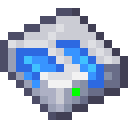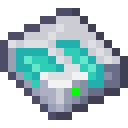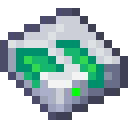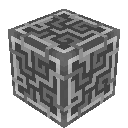Bytes and Types





Storage Cells are defined by both bytes and types. Bytes, like in your actual computer, are a measure of the total amount of "stuff" in a storage cell. Types are a measure of how many different, well, types of things are stored in a cell. Each type represents a unique item, so 4,096 cobblestone is 1 type but 16 different swords with different enchantments are 16 types.
Each storage cell can store a fixed amount of data. Each type consumes a number of bytes upfront (which varies with the cell size), and each item consumes one bit of storage, so eight items consume one byte, and a full stack of 64 consumes 8 bytes, regardless of how the item would stack outside an ME network. For instance, 64 identical saddles don't take up more space than 64 stone.
Again, each item is 1 bit, so 8 items equals 1 byte. For fluid cells, this is 8 buckets per byte.
Many people complain about the limited number of types a cell can hold, but they are a necessary limitation. Cells store their data in an NBT tag on the item itself, which makes them rather stable. However, this means putting too much data on a cell can cause too much data to be sent to a player, causing an effect similar to "Book Banning" in vanilla minecraft. Additionally, having too many different types in your system increases the load on sorting and item handling. However, this limitation does not end up being very restrictive. One ME Drive bay full of cells is 630 types which is actually quite a lot as long as you don't store loads of unique unstackable items.
For this reason, types exist to "firmly discourage" you from dumping the hundreds of randomly damaged armor and tools from a mob farm directly into your ME system. Each armor piece with unique damage and enchantments has to be stored as a separate entry, causing bloat. it is recommended to filter them out of the item stream before they touch your system.
Gunning straight for top tier storage cells is generally not the best idea, since you use more resources but don't get any extra type storage. This means that all sizes of cell are still useful even lategame, as they have tradeoffs.
Below is a table comparing the different tiers of storage cells, how much they store, and a rough estimate of their cost.
Storage Cell Contents Vs Cost
| Cell | Bytes | Types | Bytes Per Type | Certus | Redstone | Gold | Glowstone |
|---|---|---|---|---|---|---|---|
| 1k ME Item Storage Cell | 1,024 | 63 | 8 | 4 | 5 | 1 | 0 |
| 4k ME Item Storage Cell | 4,096 | 63 | 32 | 14.25 | 20 | 3 | 0 |
| 16k ME Item Storage Cell | 16,384 | 63 | 128 | 45 | 61 | 9 | 4 |
| 64k ME Item Storage Cell | 65,536 | 63 | 512 | 137.25 | 184 | 27 | 16 |
| 256k ME Item Storage Cell | 262,144 | 63 | 2048 | 414 | 553 | 81 | 48 |
Storage Capacity with Varying Type Count
The upfront cost of types is such that a cell holding 1 type can hold 2x as much as a cell with all 63 types in use.
| Cell | Total Capacity of Cell With 1 Type In Use | Total Capacity of Cell With 63 Types In Use |
|---|---|---|
| 1k ME Item Storage Cell | 8,128 | 4,160 |
| 4k ME Item Storage Cell | 32,512 | 16,640 |
| 16k ME Item Storage Cell | 130,048 | 66,560 |
| 64k ME Item Storage Cell | 520,192 | 266,240 |
| 256k ME Item Storage Cell | 2,080,768 | 1,064,960 |


 Applied Energistics 2
Applied Energistics 2